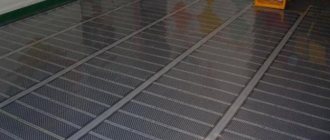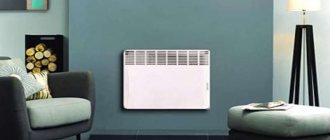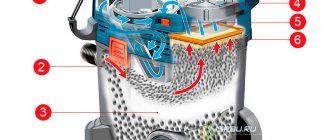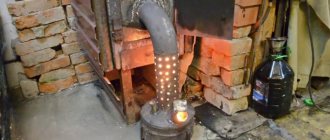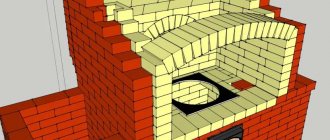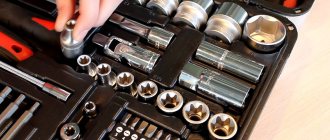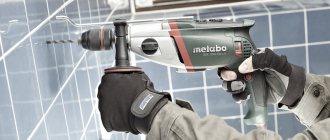Definitions of the terms “thermostat” and “thermostat”
The meaning of the term “thermostat” lies in the word itself. This is a device designed to control temperature during operation of a laboratory electric furnace. He is responsible for connecting the control system and achieving the set parameters.
The main function of the thermostat is to optimize energy consumption. It promptly turns on and off the device if it approaches the temperature limits.
Modern ovens have a built-in control panel - digital or mechanical, to choose from
What are the similarities and differences between a thermostat and a thermostat? We list the main characteristic features:
- What common? If a thermostat is used to maintain the temperature at the same level and acts as an independent device, it can be called a thermostat. If it is a modular element of the thermostat, then it is considered simply part of it. In this case, the general definition would be “thermostat”.
- What is the difference ? The meaning of the word “thermostat” may imply a separate element, while “thermostat” is a completely independent device, which includes a heat regulator.
As a separate device, a thermostat can be used to change the temperature according to specified parameters. The function of the thermostat is not to control, but to maintain temperature conditions
Criteria for choosing a thermostat
Pay attention to:
- Number of functions. Experts believe: the more functions, the easier it will be to set up heating in the house;
- The control interface should be as simple as possible, especially if elderly people or children live in the house. The overlay thermostat has one of the best control interfaces;
Main types of thermostats - Installation method. We pay attention to this parameter only in certain conditions: you plan to install a temperature sensor outdoors or in a room with high humidity, for example, in a bathroom;
- Power is the most important criterion. This parameter determines which heating system the floor heating thermostat will be combined with. If the power of the heated floor is too high, then it is recommended to install magnetic starters - devices that will protect the thermostat from overloads. Since the performance of the floor and your safety depend on the power of the temperature sensor, we recommend choosing products only from well-known manufacturers: Uriel Elektronics Ltd, Ireg, RTC, etc.
The products of the above manufacturers stand out for their modern design, excellent compatibility with all types of heated floors and the strength of the box lining. What if you do not have the opportunity to purchase a branded regulator? You can use regular one. In this case, the power of the heating system should not exceed the operating capabilities of the thermostat by more than 5%.
The main principle of operation of a mechanical thermostat
During operation of an industrial furnace, it is most often necessary to ensure its timely shutdown. Mechanical thermostats operate based on the ability of substances to change when heated. To understand how a thermostat differs from a thermostat, we will give an example of the operation of the former based on the description of its different models.
Bimetal plates
The design of such a mechanism is quite simple - two plates of different metals connected by bolts. The outer disk has a dial with printed temperature divisions.
The main principle is the unequal heating of metals. One plate heats up less and remains motionless, the second one bends when heated to a certain temperature.
Since the plates are part of a common electrical circuit, as long as they are even, the circuit is closed. After reaching a certain level of strain, the circuit breaks and the electricity stops flowing.
There are many types of bimetallic thermostats, but their operating principle is the same
Operating principle, pros and cons
Programmable thermostats come in the following types:
Operating Mechanical Thermostats
A mechanical temperature controller is considered a simple and practical device. Used for heating and cooling purposes. Most often it is an external electrical installation product intended for internal installation in residential premises in heating systems.
Mechanical programmable thermostats
The specificity of mechanical thermostats is the absence of an electrical component. The device operates on a special principle, which consists in the properties of certain substances and materials to change their mechanical qualities due to changes in temperature.
When the temperature changes to a specifically specified temperature, the electrical circuit breaks or closes, which causes the heating devices to turn off or on. The required temperature indicator is selected on the device scale by rotating a special wheel.
Positive points of mechanical thermostats:
- Reliability
- Resistance to voltage surges
- Unaffected by electronic failures
- Work at sub-zero temperatures
- Can be used in conditions of sudden temperature changes
- Simple controls
- Long service life
- Presence of error
- Possibility of small clicks when voltage is applied to infrared heaters
- Low functionality
Regardless of the shortcomings, they are the most common and are found in the organization of heating systems more often than other thermostats, due to their simple control and low cost.
Operation of electromechanical thermostats
Electromechanical programmable thermostats are used in various household electrical appliances. These products come in two modifications:
- With bimetallic strip and contact group. The plate, when heated to a certain temperature, bends and opens the contacts, which stops the supply of electric current to the heating coil or heating element of the device. After cooling, the plate bends back to its original position, the contacts close, the supply of electricity returns and the device heats up. Almost every person uses devices with these regulators in everyday life - these are irons, electric stoves, electric kettles, etc.
- With capillary tube. The product consists of a tube filled with gas and placed in a container of water, as well as contacts. The principle of operation is based on the properties of materials to expand at certain temperatures. The substance in the hollow tube begins to expand when the water heats up, causing the contact to close. After the water has cooled, the contacts open and the electrical appliance begins to warm up. Such regulators are most often equipped with water heaters, oil heaters, and boilers.
Electromechanical programmable thermostats
These thermostats have proven themselves to be unpretentious devices.
The advantages of these devices:
- Automatic heating switch on
- Tightness
- Low price
Disadvantages of these devices:
- Low functionality
- Difficulty achieving high control accuracy
Operation of electronic thermostats
Electronic devices are very common and are used with many electric heaters. They are usually equipped with general heating and air conditioning systems, as well as heated floors.
Gas sensors
The principle of operation of this design is similar to that described above. The only difference is the use of gas, which heats up and expands faster than metals. The sensor is filled with gas inside, enclosed between metal disks. When the desired temperature is reached, the expanded gas disconnects the disks, which open the power circuit. After cooling, the disks gradually move closer, closing the contacts.
Gas thermostats respond to heat faster when compared to metal thermostats
What is an external water thermostat?
The thermostat is generally understood to mean:
Thermostat for a gas boiler Save gas up to 30%
- a device used to provide a given level of air (water, air) temperature;
- a hardware module that is designed to measure the temperature of air (water or air) and transmit a signal to the control module to activate or turn off the heating (or cooling) elements when the appropriate medium reaches a specific temperature.
Likewise, there are 2 main meanings of the term in question. In the first interpretation, the external water thermostat acts as an independent gadget, which will likely be endowed with very different functions.
For example, such as ensuring the ambient temperature according to a schedule or in correlation with its moisture level. An external water thermostat in the meaning of “hardware module” can be used as part of various devices.
For example, in air conditioners, heaters and other types of climate control equipment, in refrigerators (if we are talking about the need to maintain a low ambient temperature).
How does an electronic thermostat work?
Describing thermostats and thermostats (what is the difference between them), one cannot fail to note the advantage of electronic heat regulators over mechanical ones. Their installation allows you to set and maintain the desired temperature with high accuracy, which is simply necessary when working with industrial and laboratory furnaces.
Instead of mechanical sensors, resistors are used, the resistance of which varies depending on the degree of heating. The incoming signal is processed in the electronic module, from where the command to start or stop work is issued.
The main types of thermostats are:
- Non-programmable . They are a digital display with buttons for setting the desired temperature parameters. They do not have wide functionality.
- Programmable . These devices can be compared to miniature computers. Their use allows you to set not only the temperature, but also the switching time, as well as plan specific days of operation.
- Wireless . The most modern devices that allow remote control. Using Bluetooth or Wi-Fi technology, you can control the operation of the oven from another location. In addition, problems associated with laying electrical wiring disappear.
The use of wireless technologies significantly expands heating control capabilities
How to choose a temperature sensor for an apartment, roof, street heating
Layout of a thermostat for a heated floor.
In most cases, a device for regulating the temperature of the atmosphere in an apartment or house is installed at a height of 0.8–1.2 meters from the floor in an installation box. Cables leading to the device are protected from mechanical damage by a corrugated pipe.
Experts believe that a digital programmable controller provides maximum efficiency and savings. This device contains programs for optimizing heating and energy consumption.
Such a thermostat automatically turns off if the temperature in the house rises above the set parameters or people leave their home. Try to choose thermostats from the floor manufacturer. The warranty period for such devices ranges from 1 to 3 years on average.
An overhead thermostat for outdoor heating is selected according to the following parameters:
- A remote sensor is required. The overhead regulator must withstand temperature changes from -60 to + 50 degrees;
- The heated floor controller should have an automatic switching function when the temperature drops to 0–5 degrees;
- Resistance to voltage surges, precipitation and mechanical damage;
Installation diagram of the thermostat and other components for outdoor heating
Outdoor regulators are installed in a distribution cabinet on a DIN rail or in a socket box.
Basic requirements for regulators that are placed on the roof:
Elements of the roof cable heating thermostat system
- Availability of special fastening for DIN rail;
- Possibility of connecting several indicator monitoring sensors in different parts of the roof at once;
- Possibility of synchronization with temperature and humidity sensors;
- Modern protection of the case from moisture and dust. The thermostat must have at least a minimum level of protection - IP 25. The higher the protection value, the more reliable the sealing of the housing and the less likely it is that the device on the lid will fail.
On the roof, it is better to place the temperature sensor in places where the least dust accumulates. Small particles can reduce the accuracy of data measurements and clog vital chips. Devices located on the roof must undergo an annual inspection for serviceability and resistance inside the device. Any malfunctions must be corrected immediately. [ads-pc-2][ads-mob-2]
Advantages of electronic heat controllers
The use of electronic thermostats and thermostats provides tangible benefits:
- Ability to coordinate the operation of several furnaces simultaneously.
- Mount sensors in any convenient place.
- Remote control from a computer or smartphone.
- Receive an alarm signal on your phone in case of problems.
Some devices are equipped with the ability to send electronic reports. Many models allow control using voice control
Not a single heating device, in this case a muffle furnace, is complete without a thermostat or thermostat. As you can see, although these devices have design differences, it would not be a big mistake to use any of these names.
Thermostats for electric and water transformer stations - what is the difference
In fact, there is no difference; in both cases, the thermostat performs one function - it turns the heating on or off, interrupting the supply of voltage to the actuator - the heating cable or servo drive. But not every device is suitable for working with electric floors; for example, a purely mechanical device cannot be used. Let's explain why:
- The heating of the electrical transformer is controlled by a remote sensor located in the floor between the loops of the resistive cable. It allows you to limit the maximum temperature of the floor covering and protect the cable section from overheating.
- Mechanical thermostats contain a plate that responds to changes in air temperature. The device is not designed to connect an external temperature sensor, so it does not “see” the degree of heating of the floor screed.
- Film heated floors work in a similar way. When it is necessary to regulate the air temperature, a relay thermostat is selected, equipped with an internal sensor and terminals for connecting an external one.
Electric heating transformers are always installed with a thermistor sensor that measures the floor temperature
Note. The thermostat controller simultaneously processes signals from the floor and built-in sensor. When 1 of the 2 thermistors indicates that the set temperature threshold has been reached, the electric heating is turned off.
To adjust the water heating circuits, an air-heated floor sensor is used; a remote meter is installed at will or if necessary. For example, to control edge zones that are very cold. The coolant temperature is limited by control valves on the manifold - RTL thermal heads or a mixing valve with a surface-mounted/submersible sensor.
What is a thermostat?
The term “ thermostat ” is commonly understood as:
- a home device (refrigerator or, for example, an air conditioning device), which contains an external water thermostat in the meaning of “hardware module”;
- a synonym for the term “external water thermostat” in the meaning of “independent device” under the conditions that the gadget is intended to maintain a given level of air temperature;
- a narrow-purpose hardware module, which is part of very complex devices (for example, car cooling systems) and is used to ensure a comfortable temperature for the engine that is running.
Advantages of Terneo RZ
The advantages of this thermostat lie mainly in its technical characteristics and operating features:
- compact dimensions;
- adjustable hysteresis, that is, the temperature difference on the basis of which the device turns on/off;
- the ability to connect any device compatible with the thermostat;
- Terneo RZ has a function to control the operation of multiple devices;
- wide temperature range: 0-30˚С;
- when using Terneo RZ, 40% savings in electricity ;
- Terneo RZ does not require manipulation of indoor wiring;
- safety of operation (protection from children, protection from overheating);
- Possibility of use with devices that support cooling mode (air conditioner, fan, etc.);
- affordable price. When purchasing a thermostat, the costs are recouped within a few months, which undoubtedly makes it a profitable option for those people who are considering options for replacing the built-in thermostat of a household heater.
What breaks down in an oil heater
The tank is filled with heat-resistant oil to 85 - 90 percent. An air gap is left to compensate for the thermal expansion of the oil - the appropriate accordion housing configuration is selected. When refilling, choose transformer oil - you cannot mix types. Now we know the possible elements of the breakdown - we begin the repair.
The situation of a leaky tank is familiar: it worked, it worked, and it leaked. In the morning there is oil on the floor, the tank is empty, the device has turned off, the thermal fuse has burned out. It is worth using cold welding. FastFix for metal maintains temperatures from minus to +120 degrees Celsius. Take it out into the cold, carefully patched, and you can use it at home. FastFix for metal contains magnetic iron filings - the fastest setting material in the range. The master will have three minutes - in an hour the material will dry.
FastFix holds temperature, sold in pencil form: a polymerizing composition of the class of epoxy adhesives. The outer resin shell protects the inner hardener. Cut the composition of the pencil in the required amount, knead it with wet hands, and apply it in place. After hardening, smooth out the result with sandpaper, a grinder, or better yet, with a wet knife until it hardens completely. There are many puncture points - don’t forget to wear rubber gloves. Before use, wet your hands.
The oil heater is broken
Before applying a patch, the puncture site should be cleaned of paint, rust, and oil. Sand with fine sandpaper for tight adhesion. If the hole is on a section channel, try to leave a little room for oil flow. According to the manufacturer, the patches hold pressure (important for the master), or check with the manufacturer. There are many brands of liquid paint, choose your own. FastFix, which does not require thinning or spreading on the plastic with a spatula, is a good choice.
Sometimes there is a need to independently repair an oil heater with a burnt heating element. Fault identification: ring both branches with the switches turned off, the plug is pulled out of the socket. If the resistance is tens of ohms, the integrity of the core is in order. A short circuit or break indicates: the breakdown is here. The heating element is rolled inward - you will have to pull it out. The new one should be similar to the previous one. The tube used is steel, not copper, to avoid electrochemical corrosion.
Comparison
Firstly, the difference between a thermostat and a thermostatic valve can be identified by ensuring that the terms in question are not used as synonyms. In this case, the external water thermostat can be considered as one of the hardware modules of the thermostatic valve, and one of the main ones.
An external water thermostat installed in the thermostat records the set critical temperature and transmits a signal about the need to maintain it at the current level to other hardware modules of the device. Which activate heating or, conversely, cool the device or elements that affect the temperature of the external environment.
For its part, the term “thermostat” can be used to define the hardware component of devices whose main function is not climate control. For example, if we are talking about automotive cooling systems.
Secondly, the difference between the terms under consideration can be traced, even if it is agreed that they are used as synonyms.
The thing is that among technical professionals, in most cases, any gadget that is designed to maintain a constant ambient temperature is considered a thermostat. Under any circumstances, it will be a thermostat in the meaning of “independent device”.
But if an external water thermostat is intended to control the temperature of the external environment according to a schedule or in correlation with air moisture, then it would not be very correct to call it a thermostat.
In this sense, an external water thermostat differs from a thermostatic valve in practical purposes. A small table will help us understand the difference between a thermostat and a thermostat.
Oil heater device
Temperature conditions and oil heater tank
The operating principle of an oil heater is to transfer energy from a small heating element to oil, then through it to the surface of a steel tank. The amount of heat loss depends on the temperature difference on both sides of the plane or area. It is unprofitable to increase the first parameter - the coil will burn out. If we increase the area, we will achieve the desired result. The calculation is such that you cannot get burned on the surface of the tank, but the temperature difference with the room must be significant for heat exchange.
Normal conditions: the room is 20 degrees Celsius. Citizens raise their temperature to 35, even higher - not good for health. Manufacturers have chosen the lesser evil - the surface of the oil heater heats up to 70 ºС.
We disassembled the oil heater to determine the modes:
- Emergency thermostat KSD 301 with a response temperature of 80 degrees Celsius.
- Left brand thermal fuse set to 142 degrees Fahrenheit (61.5 degrees Celsius).
Emergency thermostats KSD 301 and thermal fuse
The first one stood as a sensitive platform on the channel of the radiator section closest to the electronic unit. The oil is in an accordion made up of sections. They are welded to each other, the seams are tacked on the outside by spot welding (dashes in reality). The accordion-radiator is non-separable, stands on a platform with wheels: it is pulled in by two steel wire brackets. On one side is an accordion in the form of a heating radiator, on the other is the cover of the electronics unit (a loud name for a couple of resistors).
Each section is flat. The upper and lower channels are cut. They are connected vertically by veins: a small amount of oil oozes through. In the lower channel, with the base facing the electronic unit, there is a heating element. Difference: the water heater does not have a thermostat. But there is a thermal fuse screwed to the base. Low temperature - 61.5 degrees (although the element does not touch the working part of the heating element). The thermal fuse is wrapped in a rubber gasket and additionally protected with heat-resistant fabric: when the oil boils, the temperature will be low.
Important! Pasteurization is carried out at a temperature of 63 degrees. The limit is selected for the heater to burn out bacteria.
A thermostat with a fixed operating temperature of 80 degrees Celsius leaned with its metal side (on two screws) against the central vertical vein of the first section. No matter how you set the modes with the upper thermostat, or press the power buttons for the heating elements sections, the limit will not be exceeded.
Models of oil heaters
The myth about the hot surface of oil heaters is not true. Maximum – 80 degrees Celsius. Then an emergency shutdown occurs with hysteresis (return on at 65 degrees Celsius).
Oil heater temperature control
We started with emergency modes for a reason. When repairing leaks or choosing cold welding, you need to know the temperature conditions (operating conditions of the glued joint). Let's move on to the main characteristics of the oil heater. The heating element consists of two unequal branches: they are switched on together or separately. Provides three operating temperature modes, differing in heat transfer. Switching is provided by two buttons located on the top of the oil heater electronic unit.
There is a thermostat under the control panel. Does not control emergency mode - it is represented by an adjustable bimetallic plate that sets the room temperature for heating by the heating element. The response temperature is not high, like the emergency one - 40 - 60 degrees Celsius, even lower. Due to the rotation of the screw, which changes the tension of the plate, the response temperature changes in the desired direction:
- By pressing the buttons, we change the heating rate of the oil, heater, and room.
- By turning up the thermostat, we ensure that the device turns off at the right time.
Avoid constant clicking of the device at night - turn on the minimum mode. During the day, use the device to its fullest to quickly obtain heat.
